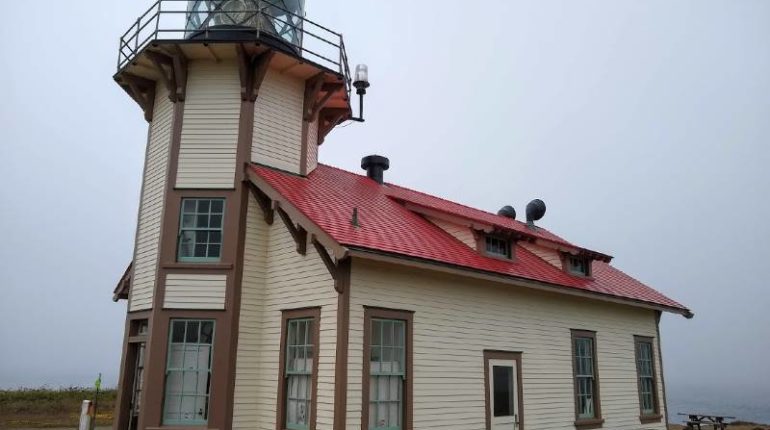Point Cabrillo Light Station State Historic Park is just a skip up the beautiful California Highway 1 only 4 miles from the town of Mendocino. The lighthouse itself and all the other historical structures are on just shy of 300 gorgeous state park acres.
This State Park came into being later than most other historical areas, starting in 1991-1992. Before that, many years were spent by many people trying to save this Preserve and Historical Light Station from developers. Basically, what you see today was saved by many volunteers and organizations local to the Mendocino area.
It wasn't until 2002 when the State of California Department of Parks took over responsibility of the park. This is also the same year when rehabilitation began on the 3 light keepers houses, as well as 3 additional outbuildings. A few of them can even be rented as vacation rentals for that ultimate unique experience!
Weather Forecast For Fort Bragg, CA:
Quick Information:
* Address: 13800 Point Cabrillo Drive
Mendocino, Ca 95460
* Phone: (707) 279-2267
* Park Hours: Sunrise to Sunset
* Established: 1991-1992
* Size: 296.5 Acres
* Elevation: Approx. 57 feet
Day Use Fee:
FREE
Dogs:
Allowed on leash
Potable Water:
No
Toilets:
Yes, flushing
Day Use Areas (Upper & Lower):
There are two main day-use areas at The Point Cabrillo light station, one is located in the upper parking lot where most people will park and contains the visitor center and bathroom area. There are large trees up here to provide nice shade with a few picnic tables sprinkle throughout.
There's also another day use area that has multiple picnic tables down by the light house area, which gives a great view of the coast and the ocean, the lighthouse and the Nature Preserve area.
This is a much better day use area than the upper parking lot area, and there are also bathrooms located fairly close by behind the first assistant light keeper's house.
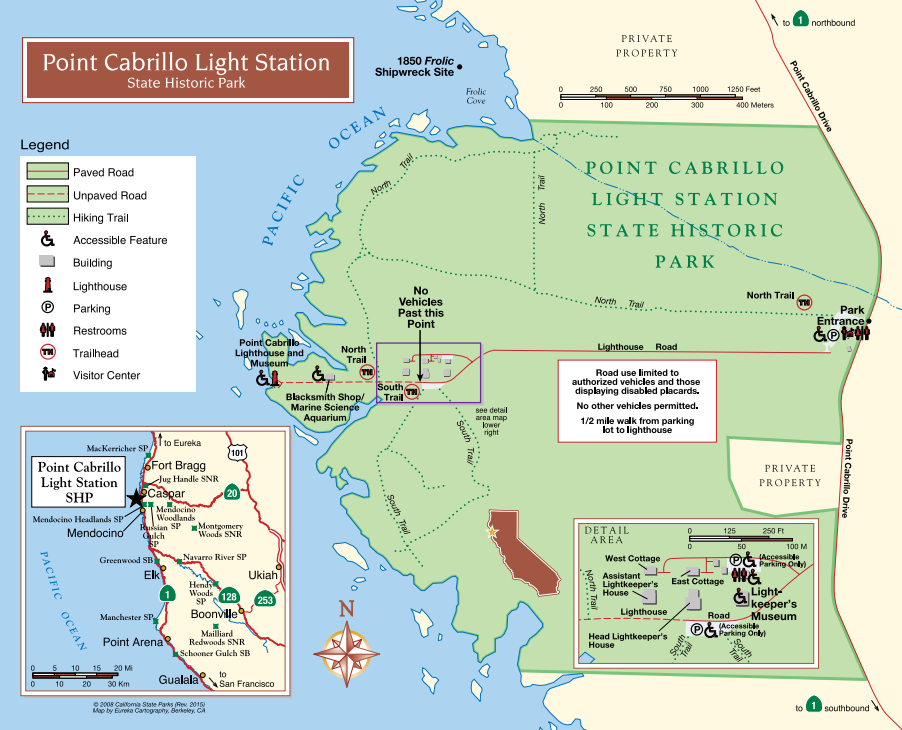
Trails:
There are 2 ways down to the light station. When facing the ocean, you can walk the paved path down to the left of the parking lot. This path is paved all the way down and is approximately 1/2 mile each way. There is a bit of a hill on the way back up, but its a really enjoyable walk.
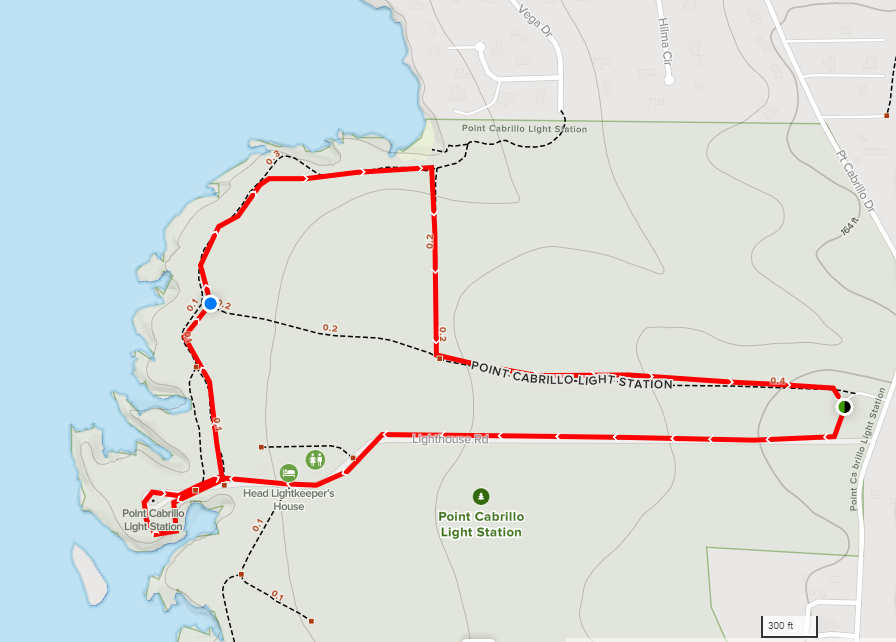
If you go to the right side of the parking lot there is an "unimproved" trail, but it is used a lot so no worries that you are heading out on an unbeaten path. It is approximately 3/4 mile. Both trails are stroller accessible with a jogging stroller for the unimproved trail.
Vehicles:
All vehicles will be parking in the day use area in the upper lot. But if you carry a disabled placard, then you have the option to drive all the way down to the light station. There are 4 or so spots available in the lower lot across from the East Lightkeepers house which is also the vintage era museum.
Bathrooms:
In the upper lot at the Visitor's Center, there are 2 restrooms available. Once you make it down to the lighthouse area, you will find that right behind the Museum, there is another restroom available. This photo is the Visitor's Center with the restrooms which are located at the upper parking lot.
The restroom down by the light station was once the detached garage for the First Assistant's Home, also built in 1909. A lot of work went into converting this once dilapidated garage into 2 handicapped accessible restrooms.
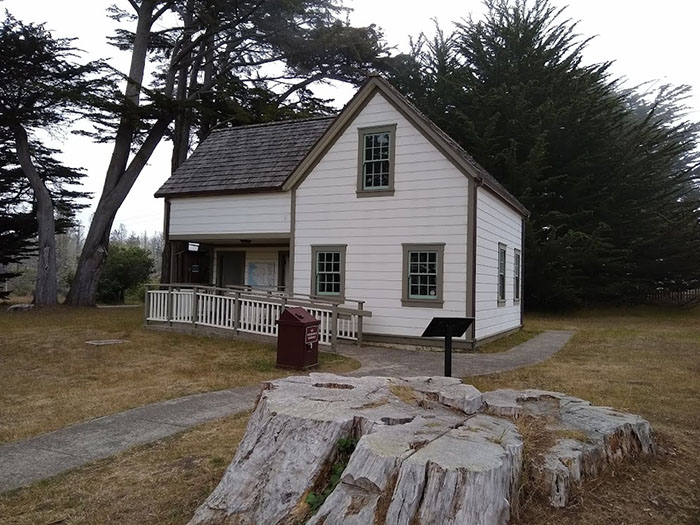
Dogs:
The Point Cabrillo Light Station State Historic Park is unique in the fact that dogs on leash are allowed in the park. Keep in mind that they are allowed on trails and not in the historical structures, except for the Second Assistant Light Keeper's Home, which is a pet friendly vacation rental.
Water:
I did not notice any drinking fountains or areas that sold water, so if you are planning a trip to the lighthouse, I recommend bringing your own water as it is quite a long walk and a slight incline on the way back. The town of Mendocino is close by, and you could grab water there or head up to Fort Bragg, which is a little further but a lot more shopping options are available.
What's There To See At Point Cabrillo Lighthouse?
This State Park was such a surprising and enjoyable place to visit. There is a lot to see in the preserved history of the light station and the buildings but also in the nature preserve surrounding the entire area.
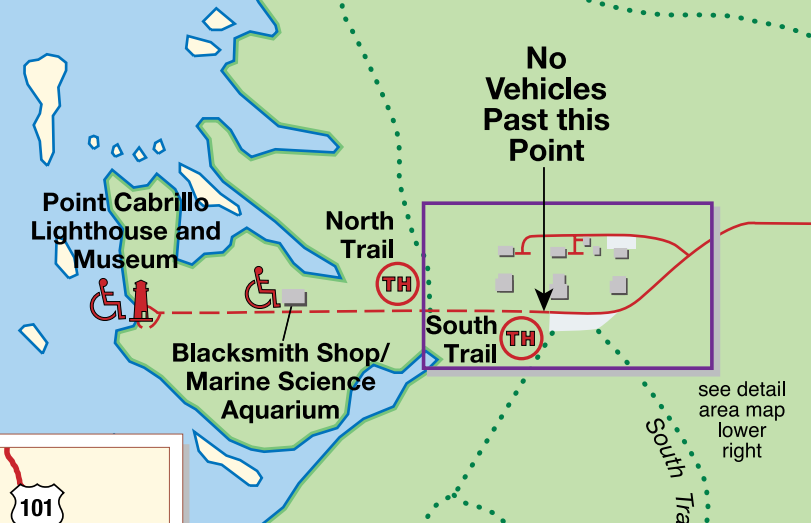
The Early Days of Point Cabrillo:
The area of Point Cabrillo sits just on the north end of the town of Caspar and a few miles even further north of the town of Mendocino. Named Point Cabrillo for Juan Rodriguez Cabrillo, who was said to be one of the first explorers of the California coast.
The area had always been seen as a potential site for a light station going back to 1873, but it was a contender with the area of Caspar as another potential place for the very much needed station.
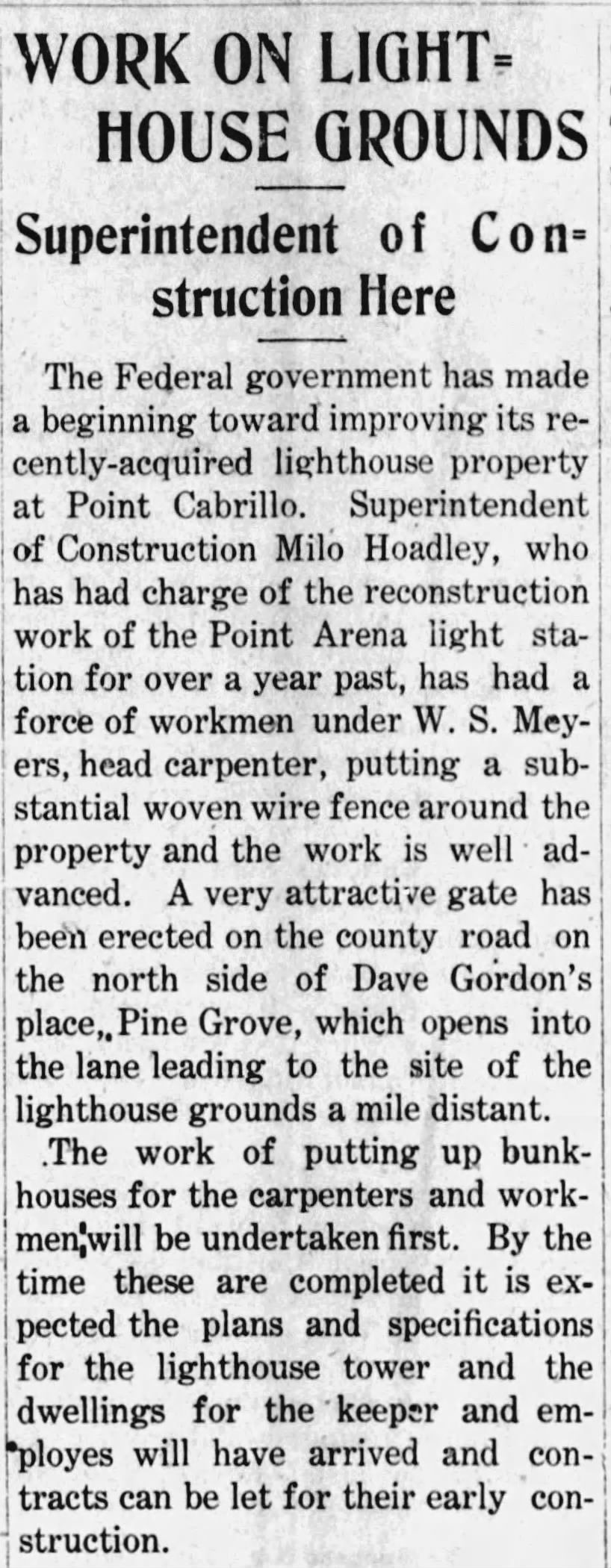
After the earthquake of 1906 that hit the Bay Area, the final approval for the light station was approved on June 20th 1906. Once the approval came, the land was purchased from local rancher David Gordon for a sum of $3,195 which today would be roughly $90,000.
The original land amount that was purchased was only 30 acres. Construction began on the light station, the three light keepers homes and a barn (the barn no longer stands and was used as a fire exercise building by the local fire department due to its state of deterioration).
Historical Buildings:
There are a number of historic buildings still standing on this property, though I am not exactly sure of how many. It seems that about 10 of the 15 of the buildings had been built in the early 1900s.
The Light Station:
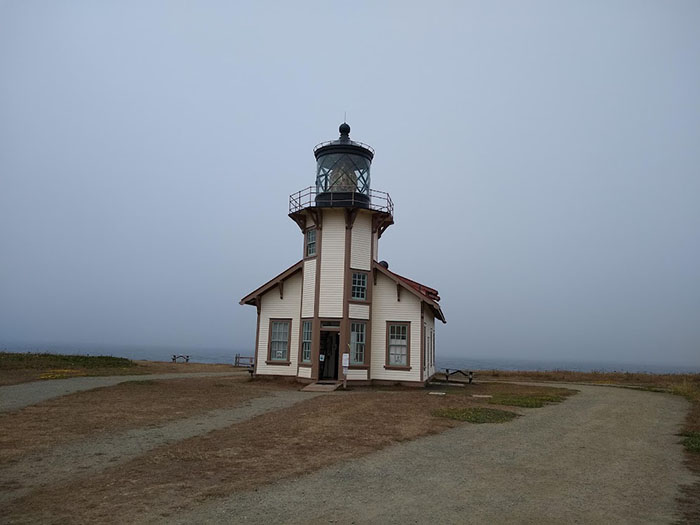
The shining gem of the property is the light station. The building itself took about 1 year to build and was completed in 1909. During that same time, the "Third Order Fresnel" lens was built out of Birmingham, England and traveled around the "horn" to its current location in Mendocino. Prior to the invention of the Fresnel lamp, lighthouses used reflector lamps which were far less powerful. The total weight of the lens is 6,800 lbs and from its location at 81 feet above the Pacific Ocean, it can be seen 14 miles away!
The Point Cabrillo Light Station is not to be confused with a "Lighthouse", as a lighthouse actually houses the Light keeper. Point Cabrillo Light Station actually used to house huge oil engines and compressors that ran the fog signal. It was actually known as the Fog Signal Building in its early stages of life.
Fresnel Lens: The Fresnel Lens was invented by French physicist Augustin Jean-Fresnel in the 1820's. In the beginning there were 6 sizes with the First Order which can measure 12 feet high by 6 feet in diameter which can reach 18 miles away.
Electricity came to the area in 1935 and at that point the oil ran engine for the fog signal was replaced by one that was electric. Today, the light station no longer houses the fog signal, as it was replaced by "whistle buoys" in and around the area.
The light station was in use and monitored by Light Keepers from 1908 till 1963. At that time, the Air Force honor guard took over duty. It was that way until 1972 when the Fresnel lens was no longer in need and was decommissioned. It was covered up and left to sit, and was even abandoned for some time before the Coast Guard began using the houses for staff.
After nearly 20 years, the Coastal Commission began negotiations to take over the Light Station in order to preserve its historical significance. The light station had seen better days and was in need of some major restoration to bring it back to its former glory.
By 1996, work began on Blacksmith (Smithy) and the Oil house. By 1998 the Fresnel lens and Lantern Room began their restoration, followed by the actual light station in 2000. Other buildings (including the light keeper's homes) were completed 2014.
The Head Lightkeeper's Home:
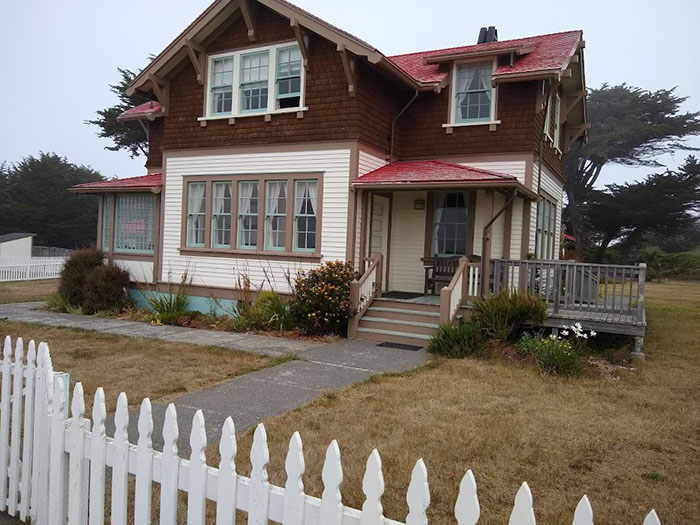
This beautiful 1909 Head Light Keepers House was lovingly restored in 2006. It is a 2-story home with 4 bedrooms, with each bedroom having its own private bathroom. When this home was restored, it was refurnished with circa 1909 furnishings, yet it still has all the modern amenities.
The first person to stay in this home would have been the Head Light keeper, Wilhelm Baumgartner who was the first Head Light Keeper in charge of Point Cabrillo. This home is available for rent as a vacation rental, for those of you out there that want a really unique experience.
The First Assistant Lightkeeper's Home and Museum:
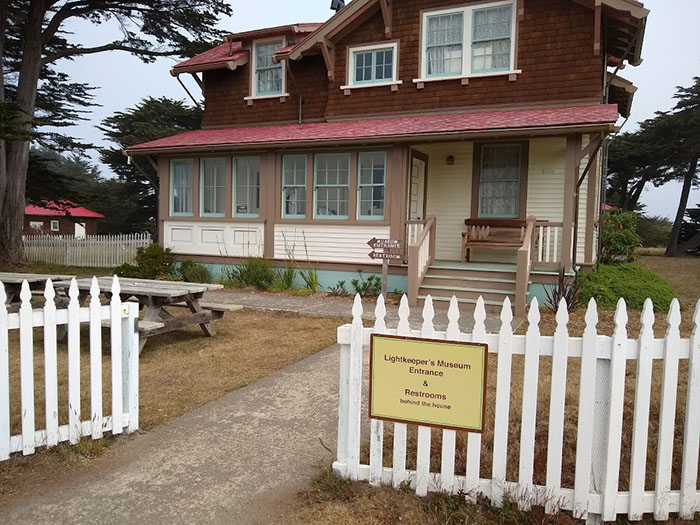
This home was the First Assistant Light Keepers home and was restored to the 1935 era, as that was when electricity was introduced. This home is now a period piece museum with some very interesting historical displays.
The Second Assistant Lightkeepers Home:
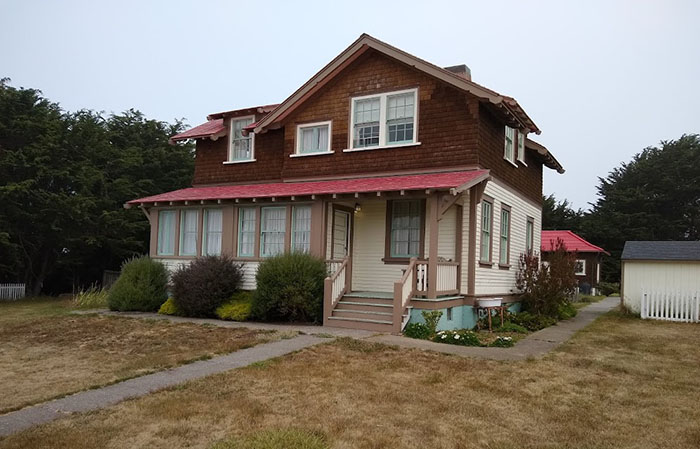
Also circa 1909, the second assistant light keeper's home was restored in 2014 and is to its original time period. This home is 2-stories tall and has 3 bedrooms and 2 bathrooms and is also available as a vacation rental.
West and East Cottage:
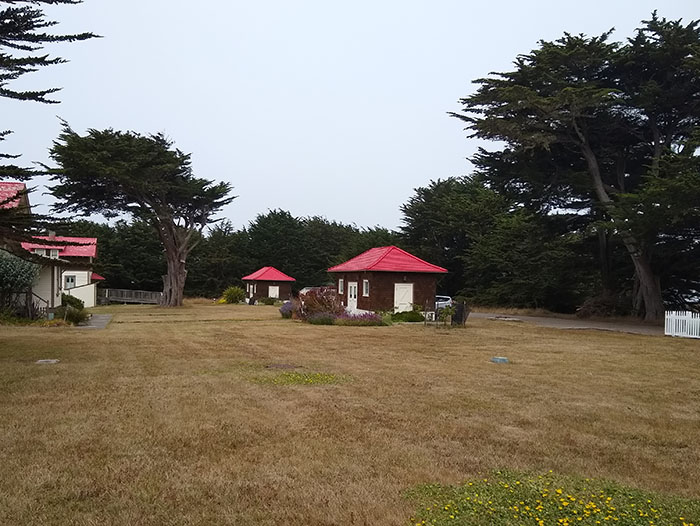
Both of these structures were restored and transformed into bungalows that are available for rent. They were previously used as storage sheds and workshops for the Head Light Keeper and the Second Assistant Light Keeper. Both units have 1 bedroom and 1 bathroom.
Smithy (Blacksmith Shop):
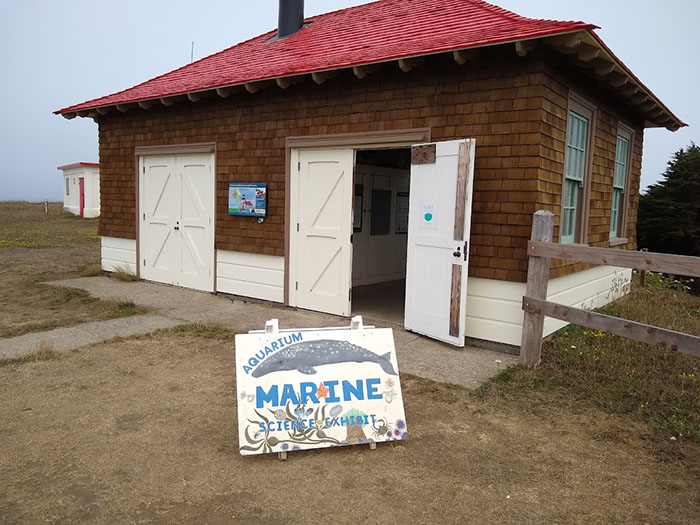
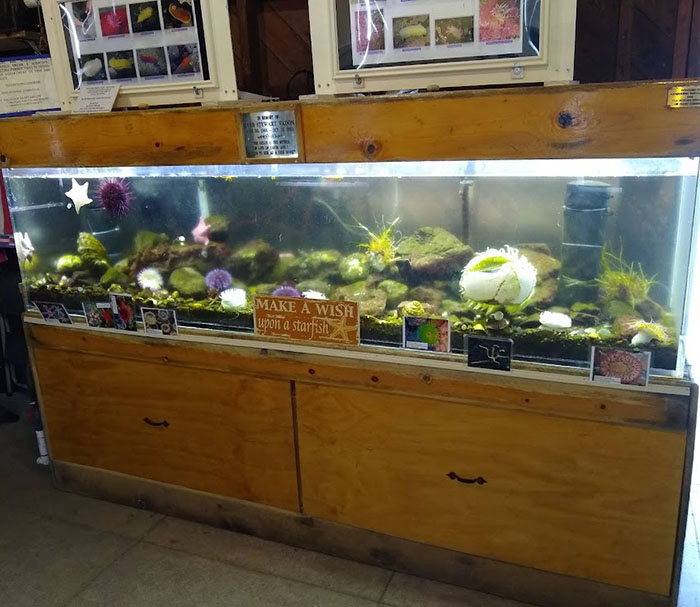
This original building has been transformed from a blacksmith building into the Marine Science Exhibit and Aquarium. In there, you will see a very happy tank full of sea critters, plus a board with an up-to-date list of recently spotted animals from the area, which includes whales, deer, birds and more.
Kearn Farmhouse/Visitors Center:

The visitor's center is located at the entrance to the park and used to be the site of the Kearn Family Farm, which was sadly burned down by arsonists in 2002. However, it has been rebuilt to look like it once did, except for the added restroom facilities on the left side of the building.
What's Nearby?
There is a lot of amenities nearby due to the fact that you have Mendocino on one side and further up Fort Bragg. Fort Bragg provides all the modern amenities like groceries, restaurants, hotels, etc. while Mendocino is a smaller town but has a lot of the same conveniences just not as many options.
Helpful Resources:
There we're a ton of helpful websites out there that I used to gather my information for this article and I listed 4 of the best websites where I gathered the majority of my information from in case any of you out there want to do further research or just get a little more information on Point Cabrillo light station for yourself.
